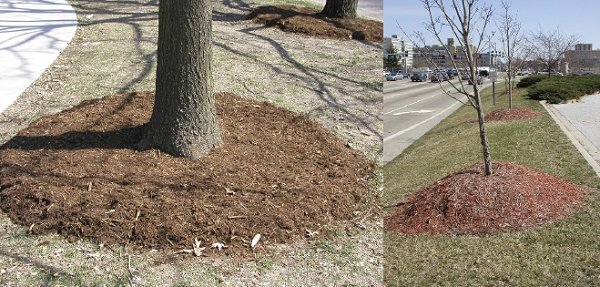AgEBB-MU CAFNR Extension
Green Horizons
Volume 21, Number 2
Spring 2017
Urban Forestry
MULCH! A Good Thing For Landscape Trees
By Gene Brunk | Missouri Community Forestry Council
Most folks know that mulching around the base of a desirable plant is a good thing. Mulching around a landscape tree is no exception; in many cases, mulch is a tree's best friend. The benefits of mulch covering all or part of a tree's root zone can be extremely important to the overall health of that tree. Mulch can reduce soil moisture loss, control weed and grass competition, protect the trunk from lawnmowers and weed whips, and improve soil structure. Mulch also gives landscapes a well-groomed appearance.
However, as valuable as mulch is to a tree's well-being, it can be harmful if applied incorrectly or too deep; or if the wrong material is used.
There are two general types of mulch: organic and inorganic. Organic mulch includes wood chips, pine needles, shredded bark, nut shells, compost mixes, and leaves. Composted wood chips (aged, exposed to aeration), mixed with other composted organics, is the best material for mulching around trees. Some organic materials such as sawdust, straw, freshly cut chips and chips aged in poorly aerated piles are not recommended.
Inorganic mulches include decorative stone, lava rock, pulverized tires, and geotextile fabrics. Such mulches are useful in xeriscape settings and high traffic areas. However, they do not make for good mulch around trees because these materials can reflect radiated heat high enough to kill thin-barked species.
Proper application of mulch is just as important as the type of mulch.
 |
Image on left is an example of a good mulch ring; at least four feet in diameter, two to four inches deep and arranged in shape of a donut with root flare exposed. Image on right is an example of "volcano" mulching, a practice discouraged by the |
Do not overdo it.
A good rule of thumb is apply two to four inches of mulch in well-drained soils; a little less in poorly drained areas. Replace as necessary (due to decomposition) to maintain the proper depth.
Make the mulch ring as large as possible.
Extending the mulch to the edge of the tree crown is preferred. However, if that takes up more room in your landscape than you desire, then try to have at least a four-foot diameter mulch ring around the tree.
No volcanos!
Do not pile mulch against the tree trunk. Pull mulch back several inches from the base of the trunk so the base of the trunk and top of the root crown are exposed. The mulch ring should resemble a "doughnut" shape rather than a "volcano."
Volcano mulching has been a tree care problem for many years and it seems to be getting worse due to misunderstandings of its ill-effects among landscape and lawn care maintenance people, and homeowners. The Missouri Community Council is piloting a public information campaign aimed at discouraging this undesirable and damaging practice in the Springfield area. Preliminary results indicate the campaign should be expanded statewide.
